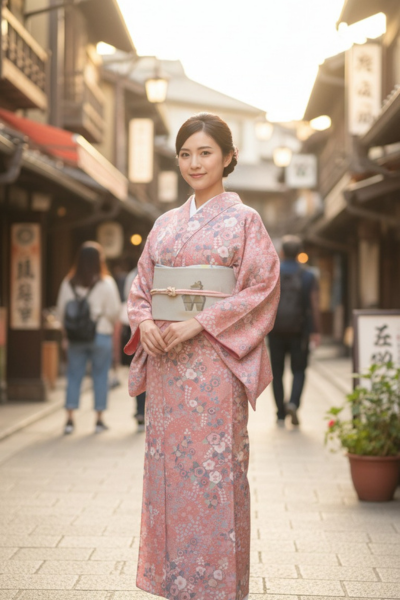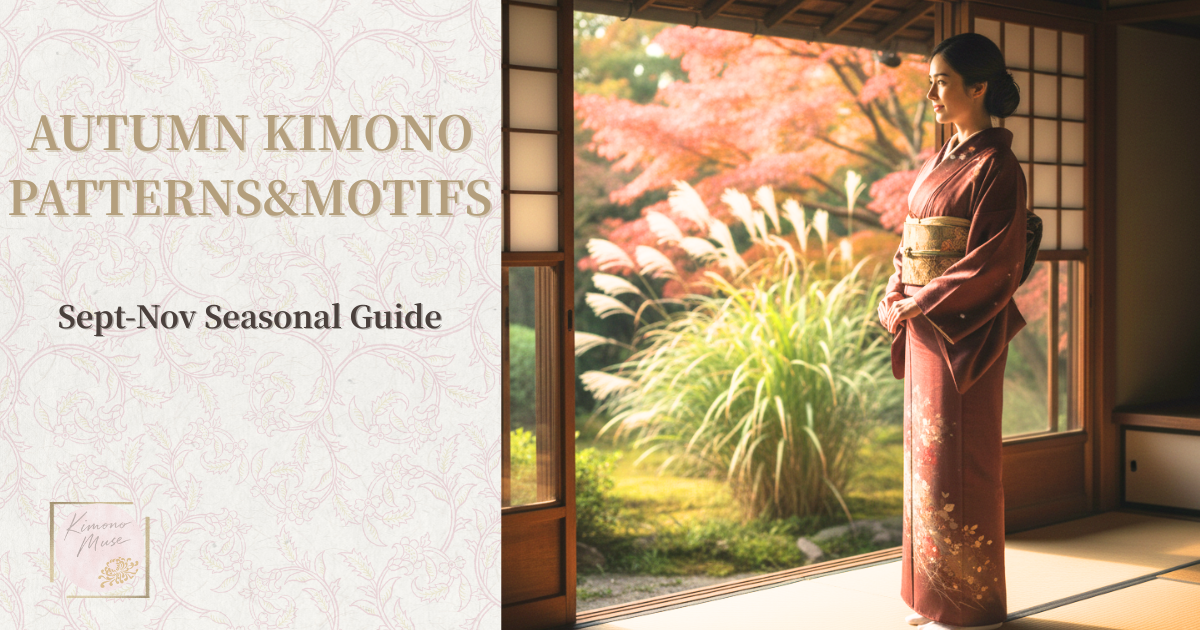Autumn is a season when kimono beautifully reflect the richness of nature, featuring motifs such as autumn leaves and seasonal grasses.
Kimono, as traditional attire, have long expressed the beauty of nature and the passing of the seasons through their patterns.
By learning about motifs suitable for September, October, and November, you can bring a sense of the season into your outfit and enjoy wearing kimono even more.
In this article, we introduce representative autumn motifs, their meanings, and tips on how to incorporate them into your attire.
Iconic Motifs that Enhance Autumn Kimono
The decorative motifs that beautifully adorn kimono embody the wishes, customs, and traditions that Japanese people have cherished since ancient times, as well as a deep appreciation for the changing seasons.
Among them, floral motifs and landscape motifs, which depict plants and natural scenery, have been especially familiar and beloved.
While it is not necessary to always choose seasonal patterns, kimono featuring flowers or natural elements of the season allow the wearer to feel the arrival of a new time of year.
・Autumn Grasses Motifs (Aki-kusa Mon’yō)
The “Autumn Grasses Motifs” depict wildflowers and plants that bloom in autumn fields.
They often feature the “Seven Flowers of Autumn” (Aki no Nanakusa): bellflower (kikyō), bush clover (hagi), patrinia (ominaeshi), fringed pink (nadeshiko), kudzu (kuzu), pampas grass (susuki), and thoroughwort (fujibakama). In addition, motifs may also include chrysanthemums (kiku) or gentians (rindō).
Sometimes these plants are depicted together as a group, while other times a single flower, such as bush clover or bellflower, is used on its own.
Although autumn grasses are iconic symbols of the season, in the world of kimono it is customary to anticipate the coming season.
For this reason, autumn grass motifs are often worn not in the deep autumn, but rather in the lingering summer heat, as designs that “invite a sense of coolness.”
This is why such motifs frequently appear on summer kimono, obi, and yukata.
| Motif | Characteristics & Meanings | Expression in Kimono |
|---|---|---|
 Bellflower (Kikyō) Bellflower (Kikyō) | The purple, star-shaped petals are striking, and the plump buds are also beautiful. | A flower loved by the Heian poet Ono no Komachi, valued as an elegant and refined motif. |
 Bush Clover (Hagi) Bush Clover (Hagi) | Small red-purple or white blossoms bloom at the end of summer. The Chinese character for “autumn” includes this plant. | The most frequently mentioned flower in the Manyōshū anthology; a representative motif of autumn designs. |
 Patrinia (Ominaeshi) Patrinia (Ominaeshi) | A perennial with clusters of small pale-yellow flowers. Its upright form is graceful. | Also called “Omoi-gusa” (the grass of thoughts), it often appears in poems. Frequently depicted together with other autumn plants. |
 Fringed Pink (Nadeshiko) Fringed Pink (Nadeshiko) | The fine, frilled light-pink petals are charming. The name signifies “so lovely you want to stroke it.” | Symbol of femininity, as in the phrase “Yamato Nadeshiko.” Commonly used in small patterns. |
 Kudzu (Kuzu) Kudzu (Kuzu) | A vine plant that produces purple and white flowers. Also used for fibers, herbal medicine, and Japanese sweets. | Represents plants rooted in everyday life. A simple motif with warmth. |
 Pampas Grass (Susuki) Pampas Grass (Susuki) | Long regarded as sacred and used as a talisman against evil. A symbol of the harvest moon in mid-autumn. | Elegant motif with graceful curves. Frequently used in family crests and designs of autumn night scenes. |
 Thoroughwort (Fujibakama) Thoroughwort (Fujibakama) | Produces clusters of pale-purple flowers in autumn; its form resembles a folded garment, hence the name. | In the Heian period, it was dried, scented, and placed in sachets; it was even tucked into the layers of court robes (jūnihitoe). |
・Blown Together Motifs (Fukiyose Mon’yō)
The “Fukiyose” motif depicts a scenic pattern of leaves, flowers, and nuts blown together by the wind.
Traditionally, autumn plants such as maple leaves, pine needles, and ginkgo were the focus, but in modern times motifs may also include chrysanthemums or cherry blossoms, making it a design enjoyed throughout the year.
The image of fallen leaves gathering has also been interpreted as “Fuki-yose” (auspicious gathering of good fortune), symbolizing prosperity.
For this reason, it has long been regarded as an auspicious motif, used not only in kimono but also in the names of dishes and traditional Japanese sweets.
| Motif | Characteristics & Meanings | Expression in Kimono |
|---|---|---|
 Maple Leaves (Momiji) Maple Leaves (Momiji) | Symbol of longevity, good fortune, and success in life. | A classic autumn motif, frequently depicted since the Heian period. |
 Pine Needles (Matsuba) Pine Needles (Matsuba) | Symbol of marital harmony and good relationships. | Even when fallen, they remain connected at the base, representing closeness and unity. |
 Pine Cones (Matsukasa) Pine Cones (Matsukasa) | Symbol of abundance and good fortune. | With their distinctive shape, they have a strong presence and are also used in family crests. |
 Ginkgo (Ichō) Ginkgo (Ichō) | Symbol of divine protection, vitality, and good luck. | Regarded as a sacred tree, known for longevity and resilience to fire, symbolizing prosperity. |
 Ivy (Tsuta) Ivy (Tsuta) | Symbol of prosperity and vitality. | Its vigorous growth represents flourishing life, while leaf colors enhance seasonal expression. |
 Chestnuts (Kuri no Mi) Chestnuts (Kuri no Mi) | Symbol of abundance, victory, and wealth. | Associated with “winning chestnuts” for warriors, and the golden brown color suggests treasure and fortune. |
・Moon-Viewing Motifs (Otsukimi Mon’yō)
The moon-viewing motif is a traditional kimono design featuring patterns related to the moon.
Moon motifs are regarded as auspicious symbols representing peace and prosperity, while also expressing beauty and mystery.
In the Heian period, moon-viewing was a pastime among the aristocracy, and by the Edo period it had spread as a harvest festival enjoyed by the wider public.
In kimono designs, the moon is often paired with rabbits, grapes, or other natural elements, symbolizing the blessings of nature and wishes for happiness.
| Motif | Characteristics & Meanings | Expression in Kimono |
|---|---|---|
 Rabbit (Usagi) Rabbit (Usagi) | Considered a messenger of the moon, symbolizing good fortune as it “calls the moon” (tsuki). Its long ears gather blessings, its leaping form signifies vitality, and its many offspring represent prosperity and fertility. | A popular symbol of happiness, frequently depicted on obi and accessories. |
 Moon (Tsuki) Moon (Tsuki) | In contrast with the sun, the moon symbolizes authority. Moon motifs are also known as auspicious symbols representing peace and prosperity. | Still widely used today on obi and small patterns, evoking the seasonal beauty of autumn. |
 Grapes (Budō) Grapes (Budō) | A symbol of abundance and prosperity across generations, loved as an auspicious motif. | Realistic grape motifs are used as autumn designs, while stylized combinations such as grape-and-karakusa vines are enjoyed year-round. |
・Other Autumn Motifs
| Motif | Characteristics & Meanings | Expression in Kimono |
|---|---|---|
 Chrysanthemum (Kiku)«①» Chrysanthemum (Kiku)«①» | An auspicious flower believed to ward off evil and bring longevity. | The highest-ranking floral motif, also used in the imperial family crest. Widely popular from formal wear to everyday kimono. |
 Gentian (Rindō) Gentian (Rindō) | A bell-shaped flower in light purple, symbolizing resilience as it continues to bloom even after frost. | Appears in Heian literature; the “笹竜胆 (Sasa-rindō)” crest is well known as the emblem of the Minamoto clan. |
 Pomegranate (Zakuro) Pomegranate (Zakuro) | Its many seeds symbolize prosperity of descendants. | In China it is considered an auspicious motif; in Japan it also represents the demon-quelling goddess Kishimojin. Suitable for autumn but also used year-ro |
Seasonal Motifs Recommended for September, October, and November
By incorporating motifs appropriate for each season, your kimono attire gains depth and refinement.
Here, we introduce recommended motifs for September, October, and November, along with the levels of formality in kimono that best suit them.
Motifs Suitable for September
September is the season when motifs inspired by the Mid-Autumn Moon and autumn grasses shine beautifully.
By incorporating these designs slightly ahead of the season, during the lingering summer heat, you can create an impression that is both refreshing and autumnal.
 Rabbit Motif (Usagi Mon’yō)
Rabbit Motif (Usagi Mon’yō)
Often combined with the moon as an auspicious design. Perfect for the Mid-Autumn Moon (late August to September). Rabbit motifs alone can also be worn throughout the year.
 Moon Motif (Tsuki Mon’yō)
Moon Motif (Tsuki Mon’yō)
Since ancient times, the moon has been revered alongside the sun as an object of faith, and loved as an auspicious symbol. When combined with rabbits or autumn grasses, it strongly evokes the feeling of autumn.
 Autumn Grasses Motif (Akikusa Mon’yō)
Autumn Grasses Motif (Akikusa Mon’yō)
Depicts flowers such as bellflower, bush clover, patrinia, fringed pink, kudzu, pampas grass, and thoroughwort. Sometimes paired with butterflies or deer. A staple motif that allows you to anticipate autumn coolness from summer into early autumn.
 Bellflower (Kikyō)
Bellflower (Kikyō)
A purple, star-shaped flower, one of the “Seven Flowers of Autumn.” Well-suited for the lingering summer (late August–early September). Often combined with other autumn grasses or patrinia.
 Bush Clover (Hagi)
Bush Clover (Hagi)
A representative flower of autumn, also called “Shikanokusa” (deer grass). Its pairing with deer is a classic design, making it central to autumn grass motifs.
 Patrinia (Ominaeshi)
Patrinia (Ominaeshi)
A perennial bearing clusters of pale-yellow flowers. Blooming from July to October, it is suitable for wear between summer and autumn, often depicted together with bellflowers or bush clover.
 Fringed Pink (Nadeshiko)
Fringed Pink (Nadeshiko)
With its charming blossoms, it symbolizes the “Yamato Nadeshiko.” Wearing it in the lingering summer (August–September) allows you to anticipate autumn. Sometimes paired with autumn grasses or butterflies.
 Kudzu (Kuzu)
Kudzu (Kuzu)
A vine symbolizing vitality and strong life force. Featured as part of autumn grass motifs, often depicted alongside bellflowers or bush clover.
 Gentian (Rindō)
Gentian (Rindō)
A purple, bell-shaped flower symbolizing strength. At its best in September, and sometimes combined with chrysanthemums or bellflowers.
 Pomegranate (Zakuro)
Pomegranate (Zakuro)
A fruit symbolizing prosperity of descendants. Realistic depictions are suited for September–October, while stylized motifs can be worn year-round.
 Grapes (Budō)
Grapes (Budō)
A symbol of abundance and prosperity across generations. Realistic grape motifs are for autumn, while stylized grape-and-karakusa vine designs are classic motifs wearable throughout the year.
 Blown-Together Motifs (Fukiyose)
Blown-Together Motifs (Fukiyose)
Depict leaves and grasses scattered and gathered by the wind. Often combined with autumn grasses and maple leaves, as well as cherry blossoms, bamboo, seasonal flowers, and plum blossoms. A versatile motif that can be worn year-round.
Motifs Suitable for October
October is the season for motifs featuring flowers and fruits that symbolize the height of autumn, as well as designs that anticipate the beauty of autumn foliage.
 Pomegranate (Zakuro)
Pomegranate (Zakuro)
A fruit symbolizing prosperity of descendants. Realistic depictions are best suited for September–October, while stylized designs can be worn year-round.
 Grapes (Budō)
Grapes (Budō)
A symbol of abundance and generational prosperity. Realistic grape motifs are for autumn, while stylized grape-and-karakusa vine designs are classic motifs wearable throughout the year.
 Chrysanthemum (Kiku)«①»
Chrysanthemum (Kiku)«①»
A flower symbolizing longevity and prosperity, also associated with the Double Ninth Festival (Chōyō no Sekku). Realistic chrysanthemums are most fitting for October–November, while stylized motifs can be worn year-round.
 Maple Leaves (Momiji)
Maple Leaves (Momiji)
A representative motif of autumn. Though the peak season is late November, it is chic to wear them in October ahead of time. Variations include the “Tatsutagawa” design, combining flowing water with maples, as well as motifs pairing cherry blossoms with maples or showing green and red leaves together. Cherry-blossom-and-maple designs are suitable for year-round wear.
Motifs Suitable for November
November is the time when autumn leaves reach their peak, making motifs that symbolize the deepening of autumn especially fitting.
 Chrysanthemum (Kiku)
Chrysanthemum (Kiku)
A flower symbolizing longevity and prosperity, also associated with the Double Ninth Festival (Chōyō no Sekku). Realistic chrysanthemums are most fitting for October–November, while stylized motifs can be worn year-round.
 Maple Leaves (Momiji)
Maple Leaves (Momiji)
A representative motif of autumn, most striking in November at the height of the season. Variations include the “Tatsutagawa” design combining flowing water and maples, the pairing of cherry blossoms and maples (Sakura Momiji), and motifs depicting both green and red leaves together.
 Tatsutagawa
Tatsutagawa
A classic motif combining maple leaves with flowing water, symbolizing the deepening of autumn. Among maple designs, this is especially well-suited for November.
«①»Chrysanthemum Motif
Chrysanthemums were introduced from China during the Nara to Heian periods and became widely cherished by the Kamakura period. They symbolize longevity and are associated with legends of long life, such as Kikusui (chrysanthemum water) and Kiku Jidō (the Chrysanthemum Boy).
On the ninth day of the ninth lunar month, the Double Ninth Festival (Chōyō no Sekku, also known as the Chrysanthemum Festival) was held, during which people floated chrysanthemum petals in sake or placed chrysanthemum cloths (kiku no kisewata) to ward off evil and pray for long life. Today, the chrysanthemum is also well known as the crest of the Japanese Imperial Family.
As a kimono motif, chrysanthemums come in a wide variety of designs, such as:
- Mujina-giku – Small petals drawn densely. Often used in Edo-komon and yukata.
- Kiku no Maru – A round design featuring chrysanthemums, often combined with other “flower circles” such as pine, plum, or cherry.
- Rangiku – Expresses chrysanthemums in full bloom with long, flowing petals. A bold and dynamic design.
- Kikusui – A combination of chrysanthemums with flowing water, symbolizing longevity and prosperity. Also used in family crests.
How Autumn Motifs Relate to Kimono Formality


Formal Wear (Hōmongi)
A beige hōmongi decorated with folding fans and autumn flowers such as chrysanthemums, bellflowers, bush clover, and maples creates a graceful seasonal look. Paired with a subdued vermilion fukuro obi featuring auspicious motifs like bamboo and phoenixes, it is well suited for weddings, tea ceremonies, theater, and other formal occasions.
🍂Motifs of High Formality
Chrysanthemum 
Tatsutagawa
Blown-Together Motifs
Maple Leaves
Autumn Grasses Motif


Edo Komon
A pale pink Edo komon with fine patterns works as semi-formal wear. Paired with a white Nagoya obi featuring maple leaves, it brings an autumn touch, perfect for casual tea gatherings or theater outings.
🟪Semi-Formal Kimono Motifs
Chrysanthemum 
Tatsutagawa
Blown-Together Motifs
Maple Leaves
Autumn Grasses Motif
🟨Everyday Kimono Motifs
Ginkgo 
Rabbit Motif
Moon Motif 


Komon (Everyday Wear)
This stylish komon features a pink ground with tsujigahana motifs. Though decorative, it retains a casual feel, making it perfect for outings or informal dinners. Depending on the choice of obi and accessories, a komon allows you to express both the season and your individuality.
🟡Casual Wear
Ginkgo 
Rabbit Motif
Moon Motif 
Pomegranate
Fringed Pink 
Chestnuts 
Summary
Autumn kimono feature a wide variety of motifs, from dignified designs such as chrysanthemums and maple leaves to more familiar patterns like ginkgo and rabbits.
With Edo komon and komon, the coordination of obi and motifs allows them to be worn for both formal occasions and everyday style.
Why not embrace the changing seasons by incorporating motifs unique to September, October, and November into your attire?


